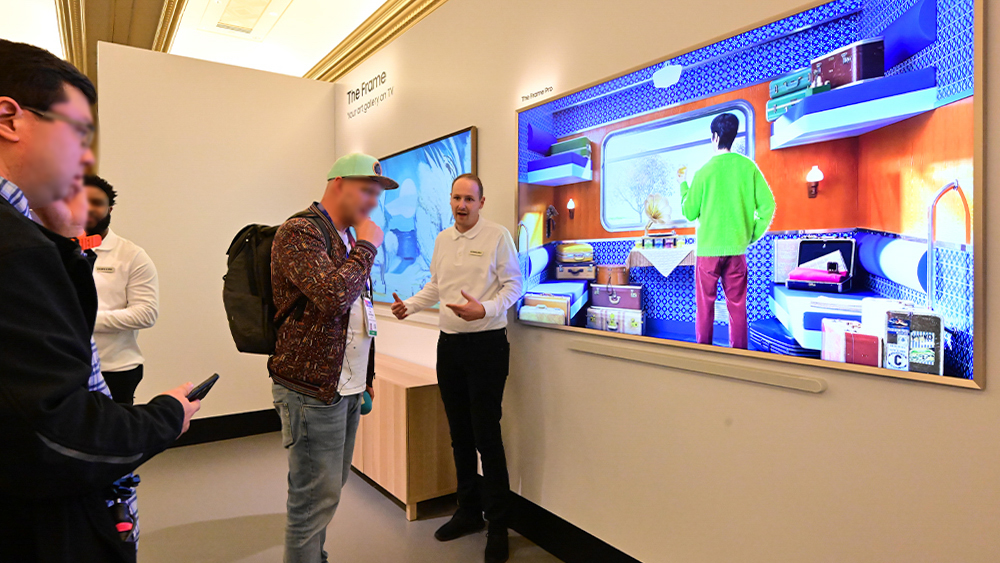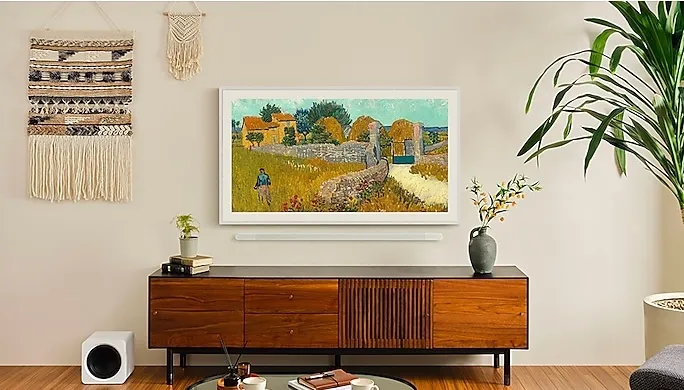Samsung Frame Pro: The Frame finally becomes the perfect TV

After years of reviewing Samsung’s Frame TV range, I’ve long wished it packed a punchier picture. The Frame Pro is here for 2025 and it’s the answer to my prayers.
What is Samsung’s The Frame Pro?
In short, The Frame Pro TV takes everything great about The Frame’s design and upgrades it with a better processor, better screen/panel technology and more for 2025.
The Frame is Samsung’s line of ‘lifestyle TVs’. To decode that for you, it basically means they’re TVs (in the past) that put design first and performance second. You can get TVs that do the job better, but you won’t be able to get one that does it quite as stylishly.
The Frame’s big claim to fame is that it’s a TV when it’s on, and an art frame when it’s off. And thanks to its QLED panel which doesn’t burn in like OLED might, you can show the art a lot longer without damaging your expensive TV.
The Frame has been around since 2017. Every year a new model came out, I would review it and find the same thing. It looks great, but I wish the actual panel inside the TV were better.
Now Samsung has announced what it’s calling The Frame Pro. A TV that – on paper – looks like it will have a picture that’s almost better than it looks on the wall. And that’s really saying something.
The Frame vs The Frame Pro: what’s the difference?
While previous iterations of The Frame I’ve unboxed, reviewed (and even purchased), use Samsung’s QLED panel to power the picture, The Frame Pro has a few secrets that make it pro by name and pro by nature.
It’s packing better screen tech thanks to Mini LED
In a standard QLED TV, like The Frame models I’ve reviewed in the past, you can expect around 1000 LED backlights illuminating the image of a 55-inch panel. These backlights are controlled in different zones to ensure that black scenes stay black.
The drawback to QLED is that there aren’t enough of these “dimming zones”, so sometimes black scenes can look washed out. There isn’t enough precision with this number of LEDs to truly nail the colours a scene is trying to represent.
Samsung’s new Neo QLED panel in The Frame Pro uses something called Neo QLED. This is basically marketing hype for what’s known as “Mini LED” technology. It’s based on the same principle as regular QLED, except there are tens of thousands of little LED lights. This allows for much greater precision for contrast.
More LEDs means more dimming zones, which means less of that grey/white “halo” when you’re watching a dark scene that needs a lot of contrast. Simultaneously, it also means more lifelike images all round thanks to a brighter and sharper image.
According to some reports out of CES, The Frame Pro doesn’t have the same quality Neo QLED display you’d see in some of its high-end TVs, but I’m not too worried. The Mini LED-powered Neo QLED display is what I’m cheering about most on the new Frame Pro. A panel that truly cuts the mustard. Finally!
It connects with no cables (seriously)
If you’ve ever seen The Frame, you know its party trick is to hang on the wall with just a single cable connecting it to power and other inputs. It’s how it makes it look like a photo frame instead of a TV.
Samsung dubs the tech the “One Connect Box”, which is where all the cables plug into before running to the panel with a clear thin cable you barely notice.
The Frame Pro goes one step further, however, and bins the cable altogether. That’s right: the Frame Pro comes with a wireless One Connect Box that beams content from stuff plugged into the box to the panel.
The panel obviously still needs power to run, so there’s a cable for that, but hopefully it’s even thinner and more discreet than the previous model. We’ll know more when we take a look at it later on in 2025.
You get a more powerful processor for better picture
TV processors are doing a lot of work to make your picture look as good as it can. The more powerful and clever the processor, the more likely you are to get a vibrant and lifelike picture.
The Frame Pro is packing a new processor from Samsung, which it calls the NQ4 Gen3 AI Processor. It’s a processor I’ve seen before, built into the high-end Neo QLED models from 2024.
It features tech that can smooth out fast motion for less “tearing” of your image, AI upscaling which boosts the quality of your content, and a depth enhancer to make it really feel true-to-life when you watch.
It also does a lot of clever sound stuff – like object tracking where it pushes the sound to different channels around you for better immersion. More importantly, though, it has a voice amplifier tech which boosts speech. As someone who hates how quiet some scenes are compared to how loud others can be, this is truly my favourite feature.
And there’s more art from The Art Store
The Art Store is where you go to download some of the world’s greatest artwork to your TV. It brings your bedroom or living room to life and really delivers on the core promise of The Frame. TV when it’s on, art when it’s off.
The Frame Pro brings with it news that Samsung has acquired the rights to a few pieces from the John Michel Basquiat estate, as well as the estate of Magritte. Both are great gets and will look great on your wall.
Those without a Frame, however, can rejoice: Samsung is expanding the Art Store to more TV models. This includes those outside of the “lifestyle” TV range, like QLED, OLED and Neo QLED users.
Samsung The Frame Pro: pricing and release date
So far, the Frame Pro has only seen the light of day at CES 2025 in Las Vegas. It’s typical: CES is where most new TVs are shown these days before they come out in stores a few months later.
As a result, we don’t have pricing for the new model just yet. After tracking these launches for years, you can probably expect a 55-inch model to go for around $2000 to $2500. For the big-screen fans, you’re likely to pay around $3500 to $4000 for the 75-inch models (assuming they go that big this year).
Previously, Samsung has launched all of its TVs around April, so we should get more news in March 2025.
I’ll be back with more info on when we’re likely to see The Frame Pro and what its specs are when Samsung gives more detail later on in 2025.
Luke Hopewell is the editor and co-founder of Redaktör. He's previously been the Editor of Gizmodo, Founding Editor of Business Insider Australia, Editorial Lead for Twitter Australia and more.




